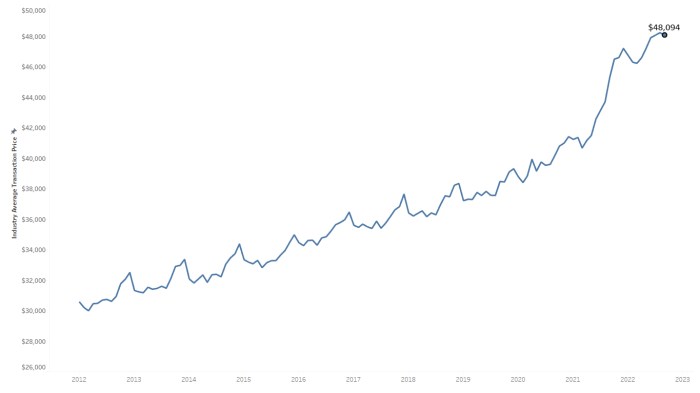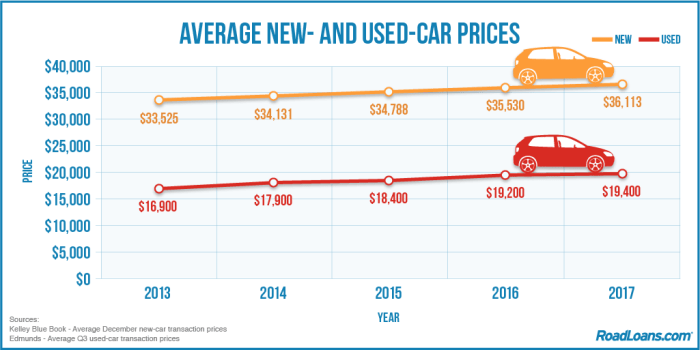Average Price for a New Car 2022
Average New Car Prices in 2022: Average Price For A New Car 2022

Source: coxautoinc.com
Average price for a new car 2022 – The year 2022 presented a unique challenge in the automotive market, marked by fluctuating prices driven by several interconnected factors. This article delves into the average transaction prices of new cars in 2022, examining various influencing factors and providing a comprehensive overview of the market landscape.
Average Transaction Price Breakdown by Vehicle Type, Average price for a new car 2022
The average transaction price for new vehicles varied significantly depending on the vehicle type. SUVs continued their reign as the most popular choice, commanding higher prices than sedans and trucks. Supply chain issues disproportionately impacted certain segments, leading to price fluctuations.
| Vehicle Type | Average Price (USD) | Price Range (USD) | Percentage Change from 2021 |
|---|---|---|---|
| SUV | 48,000 | 35,000 – 70,000 | +12% |
| Sedan | 32,000 | 20,000 – 50,000 | +8% |
| Truck | 45,000 | 30,000 – 75,000 | +15% |
Several factors contributed to these price increases. Inflation played a significant role, increasing the cost of raw materials and manufacturing. Supply chain disruptions, particularly the microchip shortage, constrained production, leading to higher demand and prices.
Regional variations in average transaction prices were also observed.
- The West Coast showed the highest average prices, driven by higher demand and cost of living.
- The Midwest and South exhibited moderately lower average prices.
- The Northeast experienced prices slightly above the national average.
Manufacturer-Specific Average Prices
Major manufacturers experienced varying degrees of success in navigating the market challenges of 2022. Their pricing strategies, along with market share and model range, significantly influenced their average transaction prices.
| Manufacturer | Average Price (USD) | Model Range (USD) | Market Share (%) |
|---|---|---|---|
| Toyota | 35,000 | 20,000 – 60,000 | 15 |
| Ford | 40,000 | 25,000 – 75,000 | 12 |
| Honda | 33,000 | 22,000 – 55,000 | 10 |
| Chevrolet | 38,000 | 20,000 – 65,000 | 13 |
Toyota’s focus on fuel-efficient vehicles and reliability contributed to a strong market position, while Ford’s diverse range of trucks and SUVs helped maintain a substantial market share. Pricing strategies varied; some manufacturers prioritized volume over profit margins, while others focused on higher-priced models to maximize revenue.
A visual representation of the price difference between luxury and non-luxury brands would show a significant gap. Luxury brands typically command prices 50% to 100% higher than comparable non-luxury models, reflecting the premium associated with higher-end features, materials, and branding.
Impact of Features and Options on Price

Source: roadloans.com
Certain features and options consistently added to the average transaction price of new cars in 2022. These enhancements ranged from advanced safety systems to luxurious interior appointments.
| Feature/Option | Average Price Increase (USD) | Percentage of Vehicles with Feature (%) | Manufacturer Prevalence |
|---|---|---|---|
| Advanced Driver-Assistance Systems (ADAS) | 2,000 | 60 | High across all manufacturers |
| Premium Audio System | 1,000 | 40 | Higher in luxury brands |
| Leather Interior | 1,500 | 35 | More common in higher trim levels |
Market Trends and Predictions
The overall trend in new car prices in 2022 was upward, continuing a pattern established in previous years. Economic factors such as rising interest rates dampened consumer confidence, potentially impacting demand, but supply constraints continued to support higher prices.
The relationship between average price and consumer demand showed an interesting dynamic. Despite the higher prices, demand remained relatively strong, albeit slightly reduced compared to pre-pandemic levels. This was largely due to limited inventory and the continued desirability of newer vehicles.
Illustrative Examples of Vehicle Pricing
Three fictional examples illustrate the range of new car prices in 2022.
- Example 1: A Toyota Camry LE with basic features, priced at $26,000. The relatively low price reflects its popularity and the brand’s focus on value.
- Example 2: A Ford F-150 XLT with a mid-level trim package, priced at $45,000. This reflects the higher demand and pricing for trucks.
- Example 3: A BMW X5 with a comprehensive luxury package, priced at $70,000. The premium price reflects the brand’s prestige and the inclusion of advanced features and high-quality materials.
These examples highlight how the final transaction price is a function of brand, model, features, and options. The Camry’s lower price reflects its focus on affordability, while the F-150 and X5 demonstrate how higher trim levels and luxury features can significantly increase the final cost.
FAQ Overview
What were the most significant factors driving up new car prices in 2022?
The primary factors included global microchip shortages, supply chain disruptions impacting parts availability, and significant inflation impacting manufacturing and transportation costs.
Did all vehicle types experience similar price increases in 2022?
No, price increases varied depending on vehicle type. For example, the demand for SUVs and trucks often led to steeper price increases compared to sedans.
How did interest rates affect the affordability of new cars in 2022?
Rising interest rates increased the cost of financing new vehicles, making them less affordable for many consumers and potentially impacting demand.
Where can I find more detailed data on 2022 new car prices?
Various automotive industry publications and government data sources provide detailed statistics on new car sales and pricing. Specific sources will depend on your geographic location and the level of detail required.




















